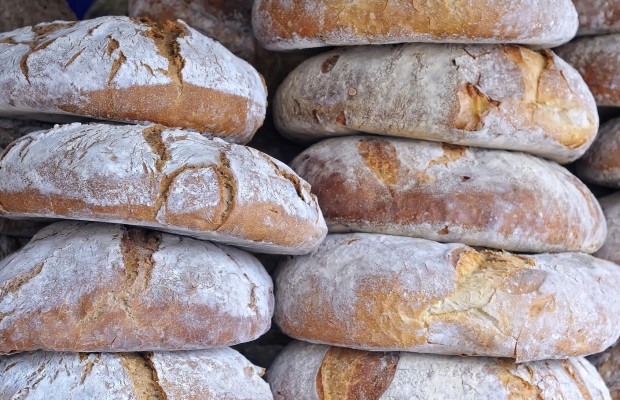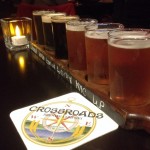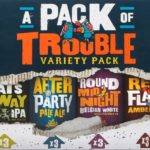HUNGRY GHOST BREAD: Artisan Bread Just Got Very Special

“Hungry Ghosts” are the spirits of insatiable desire, according to Buddhist theology. But to residents of Northampton, MA, the name Hungry Ghost is synonym with fresh-baked artisan bread. “Hungry ghosts are the souls of people who could never be satisfied and now they’re stuck in a certain realm of hell with big bellies and tiny constricted mouths and throats,”explains Jonathan Stevens, owner of Hungry Ghost Bread. “Even my friend Kato-Shonin, a local Roshi who loves the bread, implies that it’s too scary for a name –but I think we should face the things we fear.”
The scary name might have been destiny, though, as Stevens explains the day they opened (on April 10, 2004) there happened to be, by coincidence, a lecture on feeding hungry ghosts at Smith College, a block from their shop. “All spiritual traditions have a practice of offering food, often bread, to beings seen and unseen,” Stevens explains. “Think of Elijah at Passover, Shewbread in ancient Judaism, and, of course, communion in Christian churches; this is simply our hybrid, improvised and daily version of the same.”
We talked to Stevens about the many projects they’re involved in, what artisan bread is all about and why just baking bread wasn’t enough.
QUESTION: – You bake a variety of somewhat unusual breads, including the annadama mix. Can you tell us a bit about it and what makes it different?
JS: Annadama Bread has molasses and (local) corn flour. Apocryphally, it is said that some early New Englander got tired of eating it every day and yelled its new name at his wife, Anna. Aside from challah, it’s the only bread we make with sweetener.
QUESTION: You have a “bread schedule” you use to produce your breads. How does this work and why did you decide to do things this way?
JS: Our rotating, daily bread schedule reflects our desire to make –and to offer- a wide array of loaves in spite of the production limitations of our small shop. What makes one day different then another? The weather, the music flow, and the kinds of dough we’re shaping.
All of our loaves of bread are variations on a theme: they’re all naturally leavened, mixed in the a.m., given a bulk ferment all day, shaped into loaves in the late afternoon and then “retarded” in a cooler overnight, then baked the next day. The formulas don’t vary as much as some of the key ingredients –a few twists and the outcome changes drastically. All the doughs get the same 12% starter, 75% or more hydration, and 3% salt (these are based on “baker’s percentages,” an absolutely vital way of approaching recipes, using metric weights). By using different kinds of flour (from whole wheat to white and, most importantly, all the shades in between), adding some herbs or soaked grains or dusting into the basket with something other than rice flour (say, corn meal) then the varieties take on some very strong and defining characteristics.
Just this past year, we’ve tweaked some of the “standard” loaves to bring them up another notch: adding sprouted rye berries and a coating of sesame seeds to the Country bread; replacing wheat berries with malted barley and coating the loaves in oat flakes now makes the Hat Trick Loaf…these are the kinds of creative adjustments that make small-scale food production inspiring.
QUESTION: Many artisan bread makers specialize only on bread, but you make pizza and pastries as well. What made you expand into those fields and what makes your offerings different to mass-produced products out there?
JS: The pastries support my bread-making habit: the popularity and wider margins on anything sweet keep our bottom line floating finer. Customers routinely interrogate us over the purity of the loaves (organic? whole wheat?) but then turn around and order half-a-dozen cookies and a tart. That’s just dessert after all: doesn’t affect your body in the same way!
The pizza keeps us open into the evenings (also helping extend bread sales) and charges up the (wood-fired) oven so that it’s ready to bake when we arrive in the morning. Pizza shift also feeds the starter just before they leave so that it’s also ready for the early am.
Of course both our Pastry and Pizza offerings are stellar –world class. That has to do with the quality of ingredients and the care and skill with which they are made. Our team is paid well (as possible) and well-appreciated, which lowers the turnover rate and ups the atmosphere dramatically. The butter, eggs, flour, sweeteners, tomatoes, cheese, etc. are all of the best –cutting corners is never a good idea. Pastries need to be distinct, but not cloying or over-sweet. Pizza (people often forget) is a type of bread –these crusts are also naturally leavened & retarded overnight and the flour is not super-high gluten, as is often the case, which renders the results tasteless. Our sauce is made in-house, every day, and the toppings are equally fresh, often changing with the farm season.
QUESTION: Can you tell our readers a bit about the “Little Red Hen” project and how it connects to your bakery?
JS: The “Little Red Hen” is the name of a children’s story where the eponymous chicken wants to bake a loaf of bread (or in some versions, a cake) but needs her lazy barn-mates’ help to sow the grain, weed it, scythe, winnow, mill and mix it. At each juncture, the goat or mule or whoever just yawns and says, “not I!”. Of course when it’s all baked, everyone wants a piece! It takes a whole animal farm to make some food…
When we were building our first oven here, a group of kindergartners came by to watch our mason at work. He read them this kid’s book, his favorite, and they came back weeks later with beautiful tiles illustrating the tale. We mounted them around the oven and transferred them a few years ago when we expanded & installed a bigger, better unit from Spain called a Llopis.
In the spirit of shared labor, we asked our customers to help us grow experimental plots of wheat, so that we could get a sense of which varieties might grow best here in the Pioneer Valley of Western Mass. The result was very enthusiastic and the press coverage was so overwhelming (CNN, NY Times, etc.) that it helped catapult our nascent efforts into a real supply of local grains from a handful of nearby farms. Now, over six years later, we get ALL of our whole wheat, spelt, rye, corn flour plus some other products from Four Star Farm in Northfield. It is a pleasure & a privilege to use such local and fresh flour every day. That’s OUR version of the Little Red Hen.
















